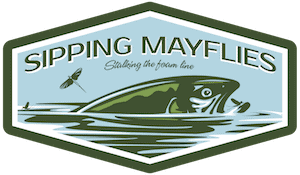Fly Fishing in the rain
[Tips, Tactics, and Flies]
Nov. 12th, 2021
Rainstorms greatly affect trout feeding behavior, but understanding exactly how is the key to being successful on the water. Successfully fly fishing in the rain is all about timing, and I’m going to explain everything you need to know.
Rain is synonomous with grey clouds, and grey clouds are synonomous with insect hatches and feeding trout. But, there are additional advantages, and even some limitations, which we’ll cover below.
One bonus you’ll enjoy is that most fly fishers leave the water once rain starts falling–what a colossal mistake on their part! You’ll have the river or lake to yourself, and the fishing action will likely be excellent.
I’m going to explain to you exactly why storm fronts and rain can lead to better fishing, tactics for different types of rain, whether to fish before, during, or after the storm, and the best flies to use in the rain.
Here’s a brown trout I caught on a midge dry fly just after light rain had passed through the area. I found myself standing in the midst of a hatch, which is a common occurrence even after heavy rainfall.
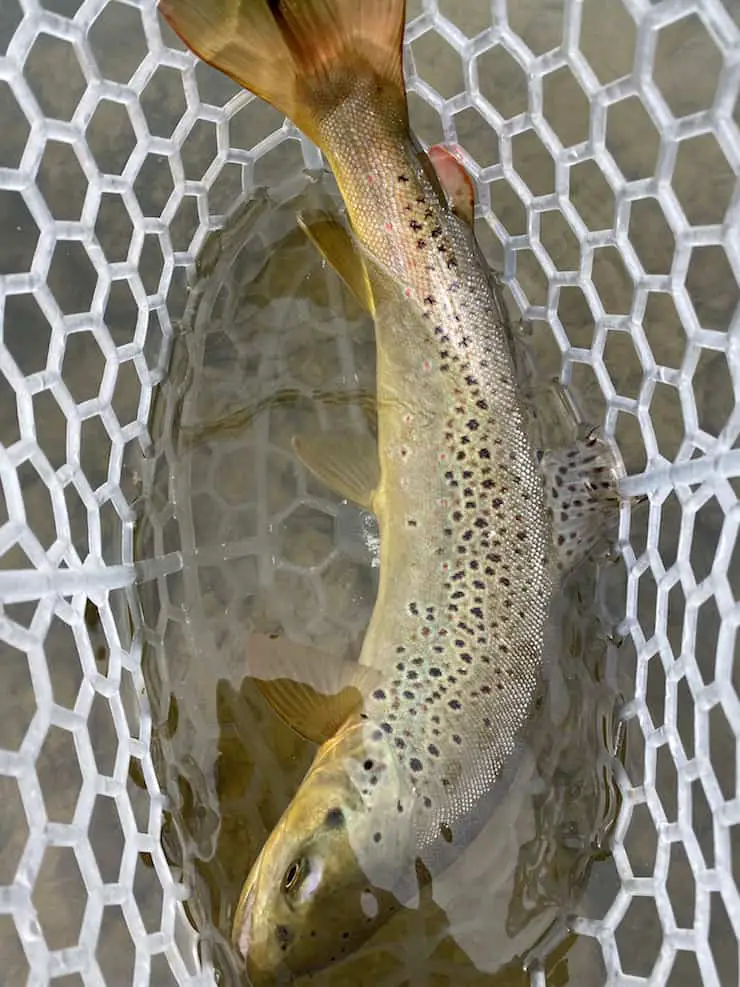
Can you Fly Fish in the Rain?
Why is Fishing Better in the Rain?
Tips for Catching Trout in the Rain
Different Types of Rain
Catching Bass in the Rain
Should I Fish Before or After the Rain?
The Best Flies to use in the Rain
Can you Fish Dry Flies in the Rain?
The Best Weather for Fly Fishing
Safely Fly Fishing in the Rain
Summary
Can you go fly fishing in the rain?
Yes, you can absolutely go fly fishing in the rain. In fact, a rainstorm can trigger some of the best fly fishing scenarios imagineable, including massive insect hatches and fish feeding frenzies, most notably with trout and other similar species.
Why is fishing better in the rain?
There are several theories as to why fly fishing in rainy weather is so productive. But, at the end of the day, even scientists and researchers don’t know exactly why rain positively affects fishing.
One theory is that rain forces aerial predators, such as birds, to roost in trees. Juvenile trout are somehow aware of this and know they can feed more safely, especially in the shallows. These juvenile fish may then attract bigger trout.
Barometric pressure is believed to play a role, but again, there are only theories.
One theory is that as a rainstorm approaches, the barometric pressure begins to drop. Since fish can feel this drop in pressure, they know a storm is coming, but they don’t know how long the storm will last, so they feed ravenously in case the storm blows out the river or makes feeding difficult due to discolored water and faster currents.
Another theory is that as the barometric pressure falls, so does the pressure on a fish’s swim bladder. This reduction in pressure allows the fish to swim and hunt more comfortably, and higher up in the water column.
Tying in with the above point, some researchers believe that as a trout’s swim bladder increases or decreases in size, the trout must move higher and lower in the water column to remain in balance.
One theory that I definitely subscribe to is that rain disturbs the surface of the water, and thus aerates and oxygenates it. The increased dissolved oxygen makes trout, baitfish, and insects more active.
It’s undeniable that rain washes insects, both terrestrial and flying, into the water for trout to eat. This can include stoneflies, dragonflies, ants, moths, mayflies, midges, and many others.
But again, the truth is, no one really knows.
Here’s a lively rainbow trout that I caught on a drizzly day in December on a size 20 parachute blue winged olive dry fly pattern. I used a parachute version of this fly because the post (parachute) made it easier to see when raindrops disturbed the surface of the water.
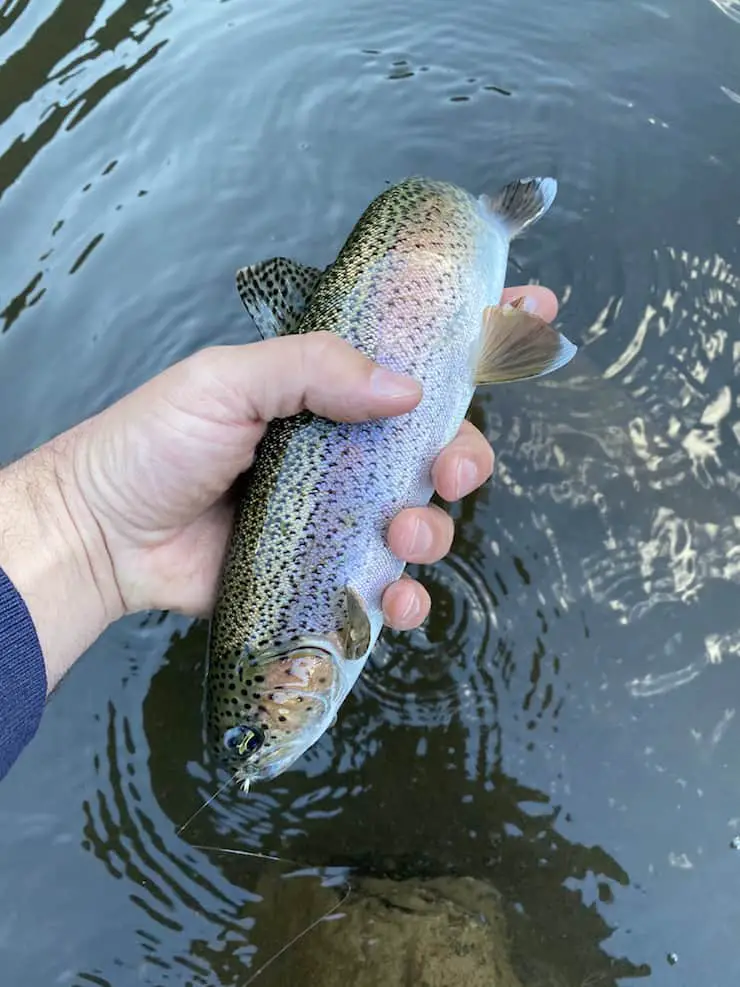
Tips for Catching Trout in the Rain
- Focus your efforts on slower water such as eddies and slack water areas. Rain can cause an increase in current and trout will want to hold in the slower water. Tying in with this, I wrote an article on how to fly fish in muddy water and spring runoff.
- When you find the slower water, focus even further on the foamlines. There’s a saying in fly fishing that “the foam is your home.” It sounds cheesy, but it’s very true.
- Dry flies can work really well during the rain, since storms flush insects into the water, including beetles, ants, grasshoppers, and even flying insects.
- Because raindrops create a pock-marked surface on the water, and the increased runoff can cloud the water mildly, the trout won’t be able to see you as well. This means you can get a little closer to the trout than you otherwise would be able to.
- Check your weather apps and get to the river early. Trout feeding activity increases noticeably as the rainstorm approaches. I’d recommend getting to the river a couple hours before the rain is supposed to begin. This is often accompanied by a cold front.
- If you’re not seeing as much action as you’d like, try twitching your dry fly on the surface. It’s not usual for this skittering action to draw a strike from a trout.
- Low light conditions are ideal for hatches, whether you end up getting rain or not. So, an impending storm (whether it materializes or not) can create a perfect environment for excellent fishing.
- Always be experimenting. Every river and lake is a little different. The method that works before the rain may not work during the rain, or after the rain.
- If the rain picks up, it may rule-out dry fly fishing. In this case, switch to streamers, nymphs, or swing wet flies.
Here’s a video I took showing a slower eddy (in the background) which is a spot that likely holds trout. The current in the foreground may hold trout as well, it’s not too fast, so you’ll want to try both spots. Notice that the eddy has water that actually moves in the opposite direction of the main current. That’s an easy way to spot eddies.
How to Fish Different Types of Rain
Fishing Light Rain
Light rain is, of course, ideal for trout fishing. This would range from a drizzle (you know, that annoying mist-type rainfall), to a soft rain that gets absorbed into the ground as quickly as it falls. In these types of rain, you can fish any method you’d like, from dry flies to nymphs. The surface of the water is relatively smooth.
Light rain can help trigger major insect hatches, since it provides humidity and the bugs won’t drown in it. Fish tend to focus on the surface during this type of rainfall, so dry flies can work really well.
Fishing Moderate Rain
Moderate rain is still very fishable, but you’re probably going to want to focus on streamers, nymphs, or wet flies, since the surface of the water may be too disturbed to see your dry fly. Alternatively, you can use larger dry flies that won’t drown in the rain, and will be easier to see.
This type of rain can drown insects that are hatching, preventing them from getting to the flight stage. The bugs that do get to flight may have a hard time staying in the air.
Fishing Heavy Rain
Heavy rain is, as you probably imagined, the most challenging to fish successfully.
The surface of the water is choppy, and so dry flies are out of the question. If you’ve got an extremely buoyand indicator, nymphing can still work.
The water levels will rise more quickly, the current will speed up more noticeably, and the water will get cloudier as a result. The water will also likely cool-down a few degrees, but this depends upon the time of year.
The trout will definitely try to find the slower water, and subsurface tactics will prevail. Specifically, you’ll want to use streamers or swing wet flies.
Any hatch during a heavy rain will be muted, since the insects will drown before they get off the surface of water. So, again, a subsurface technique is the key.
Here’s a little rainbow trout I caught after about 30 minutes prior to a moderate rainstorm. It aggressively took an elk hair caddis dry fly, one of many trout to do so on this particular day. One of the reasons I tied-on an elk hair caddis pattern is because they’re almost unsinkable in light or moderate rain.
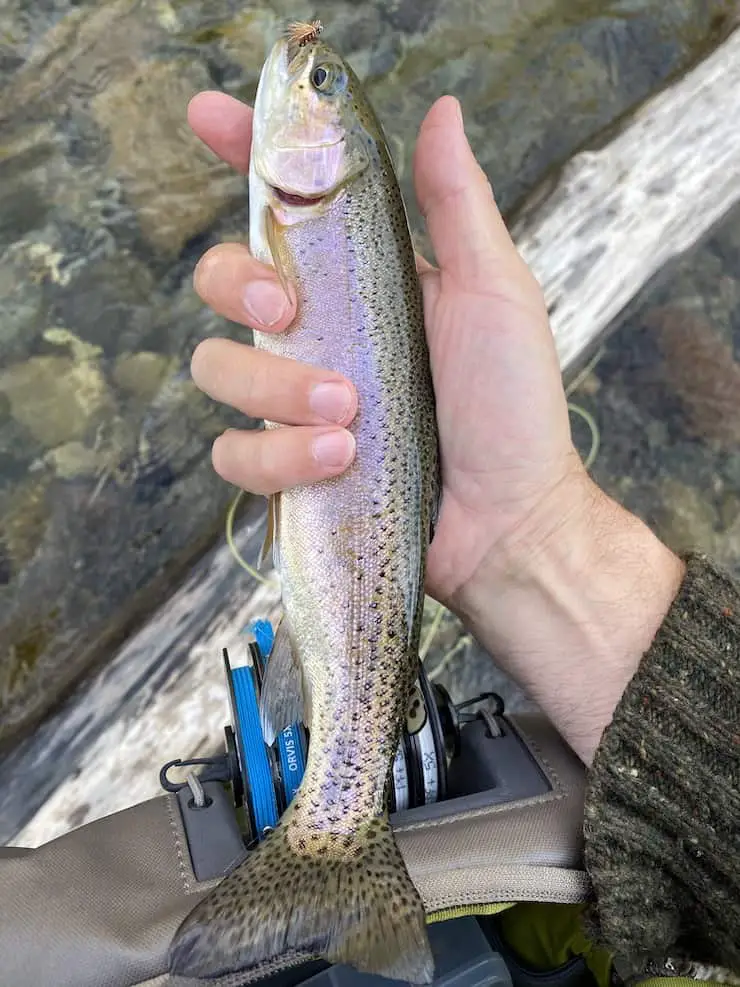
Catching Bass in the Rain
Bass are different from trout when it comes to tactics for catching them in the rain. While rain can trigger trout feeding, it can have the opposite effect on largemouth bass.
In the hours just before a storm, bass fishing can be absolutely stellar. But once it starts raining, your best technique is to switch to a topwater fly pattern such as a popper and work the surface.
Focusing on the surface will work best for bass during a rainstorm, but subsurface can work if that’s your preferred method.
Here’s a picture of the smallest largemouth bass I’ve ever caught. It was definitely picture-worthy. It took a blue winged olive dry fly just before the rain started.
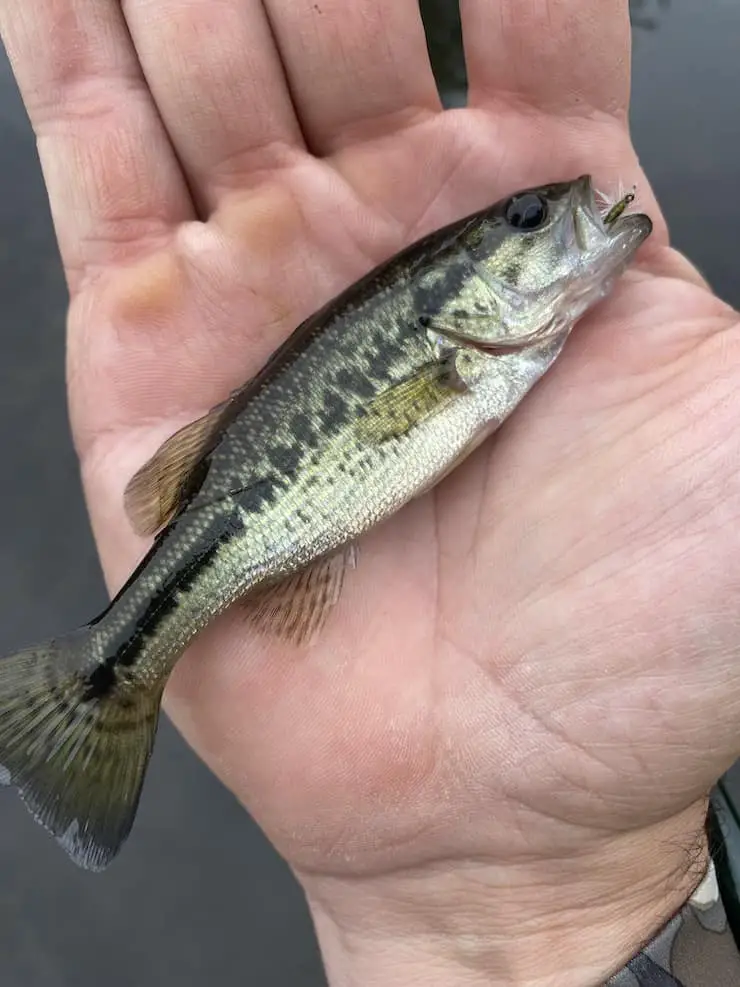
Should I Fish Before or After the Rain?
Fly fishing is usually better after the rain, as opposed to just prior to the rain. While both low pressure periods can be spectacular, if I had to choose only one to fish, I’d choose just after the rain stops. The main reason is that rainfall can help trigger insect hatches, most notably hatches of blue winged olive mayflies and midges.
There’s something beautiful about the period after a rainstorm. The air is clean and cool, and the insect hatches can be massive.
But, remember, the barometric pressure drop that precedes a rainstorm can trigger heavy trout feeding activity (for whatever reason, as we discussed above).
Ideally, you’ll be able to fly fish before, during, and after the rain. This is the low pressure window that can be so productive.
The Best Flies to Use in the Rain
The best flies to use in the rain are darker colored patterns. The general rule of thumb is that you use light flies for a light day, and dark flies for a dark day. The reason is that darker fly patterns are easier for trout to see when there’s a lack of sunlight on the water.
Dry Flies and Streamers
Since rain (especially heavy rain) can wash insects into the water, as we discussed earlier, terrestrial flies can work very well. Specifically, the dry fly patterns that have been most productive for me in the rain are the black ant, chernobyl ant, stimulator, and the fat albert.
Anything that resembles a terrestrial insect can work. Don’t agonize over your fly selection.
The stimulator pattern isn’t tied to resemble any particular insect, but it’s meaty and can attract aggressive takes from feeding trout. The chernobyl ant and the fat albert are great because they’re constructed out of foam, which doesn’t sink, making them advantageous for fishing in the rain.
If you’re tossing streamers, you can’t go wrong with the woolly bugger (in black, brown, or olive). There are many successful fly anglers who will say it’s the most productive fly they’ve ever used. You should have them in your fly box, regardless of whether it’s raining or not.
Here’s a snapshot I took to show you the various flies we’ve discussed so far.
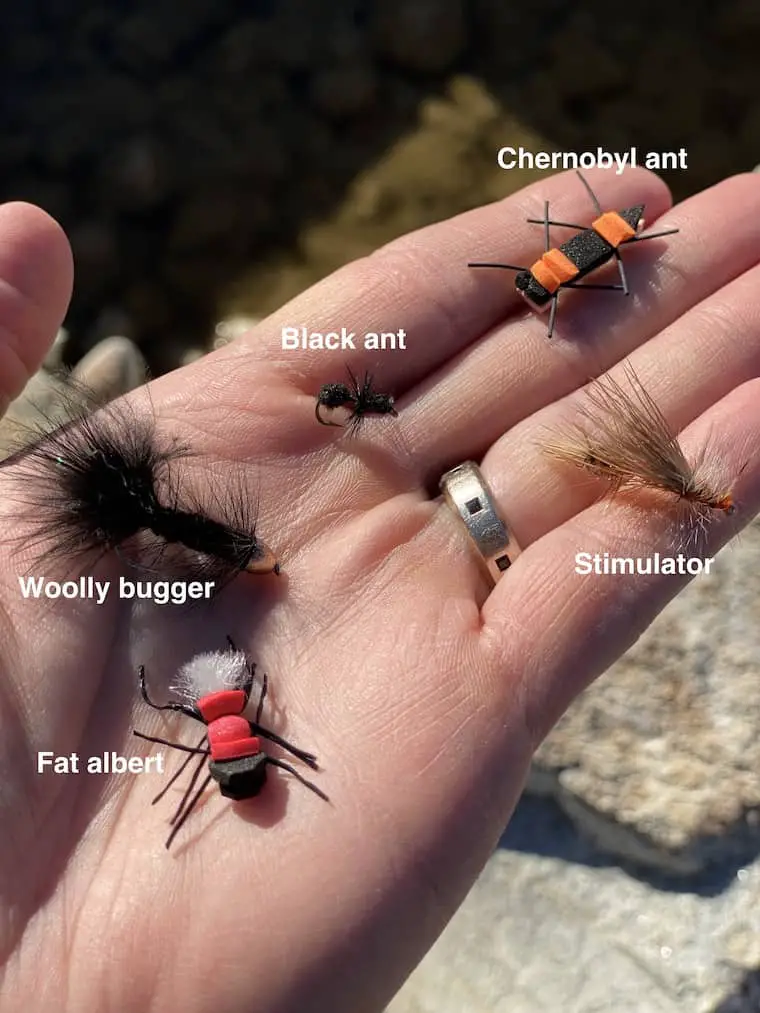
Nymphs
Nymphing can be really productive in the rain, as long as you can see your indicator clearly in the event of a take.
The best nymphs I’ve used in the rain would include the pheasant tail nymph, the hare’s ear nymph, and the stonefly nymph. I generally have the most success using the beadhead version of these, which helps me get down to where the fish are holding (near the bottom).
I always prefer using the beadhead version of these nymphs instead of adding weight to the line in the form of tungsten shot or putty. The reason is, when you add shot, it’s effectively adding a “hinge” to your setup, which can make a take less evident. I want as direct a link as possible to the trout.
One more fly pattern I’d recommend for use in inclement weather is a San juan worm. These are particularly effective after a heavier rain has literally washed worms into the river.
Here’s a quick picture of the flies we’ve discussed.
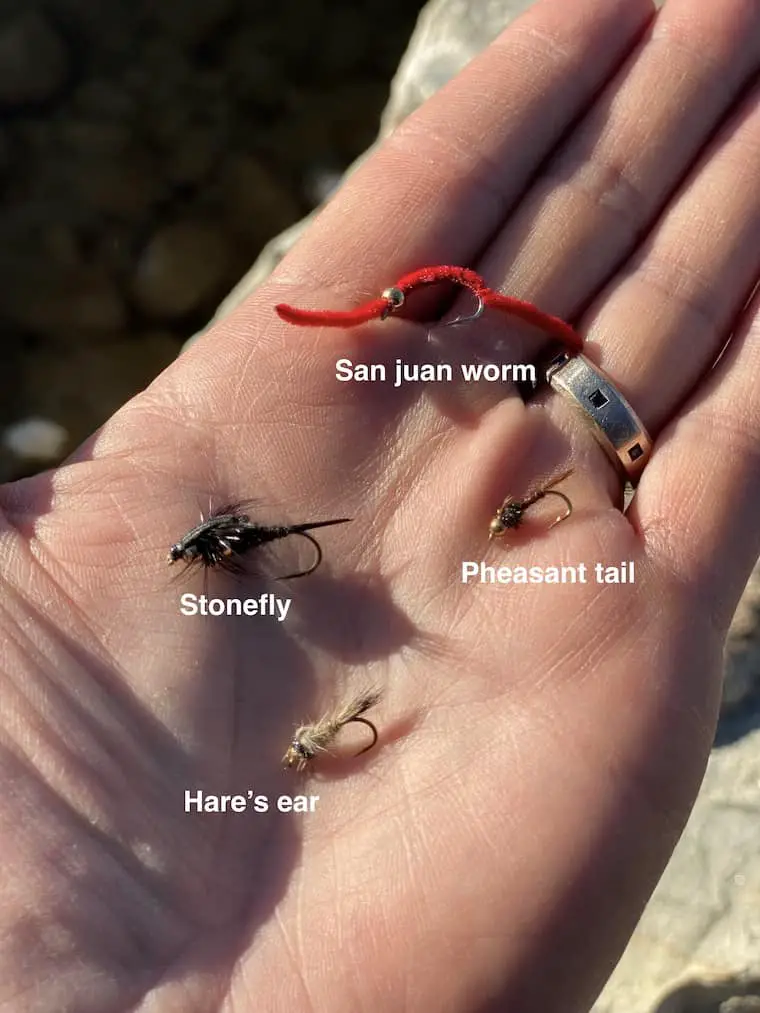
Do trout bite in the rain?
Yes, trout are one of the few gamefish that will often feed heavily during rainfall. There are two primary reasons for this behavior. Firstly, rain washes terrestrial insects into the water. Secondly, the grey skies and low-light associated with rain can trigger large insect hatches, which trout will feed upon.
Can You Fish Dry Flies in the Rain?
Yes, you can fish dry flies in the rain very successfully because rain, and grey skies, can trigger insect hatches. These hatches bring trout to the surface where they will consume both adult and emerger insects such as midges and various mayflies. The only impediment is that heavier rain can sink your dry fly.
What’s the Best Weather for Fly Fishing?
The best weather for fly fishing is inclement weather, including light rain, snow, or grey cloudy skies. This is because trout, and the insects they feed upon, much prefer low-light conditions. The exception would be during spring, when rivers are high and fast. In this scenario, rain can further dirty and chill the water, making fishing more challenging.
Here’s a picture of a rainbow trout I caught an hour or so after a moderate rain, while the barometric pressure was low. I was swinging a wet fly, specifically, a beadhead soft hackle pheasant tail nymph.
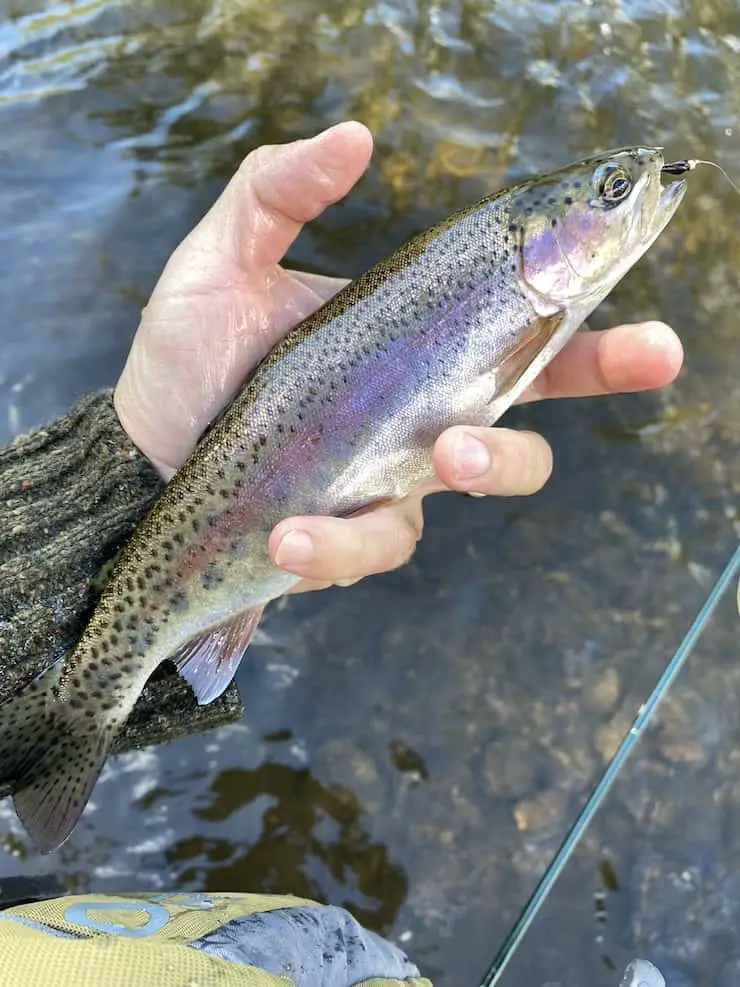
SAFety Tips
If you see lightning, get off the water. Even if the lightning looks far away, get to the shore or preferably back to your vehicle.
It’s just not worth the risk. You’re waving a 9-foot graphite fly rod in the air and yes, graphite conducts electricity.
I’ve heard some people say that they could sense a lightning strike before it occurred–they said they could smell it. It was described as an “electric” or “electro-static” smell. I’m sure it’s hard to put into words, but I think I know the smell they’re trying to describe.
Whether this is total garbage or not, I’m not sure.
If you find yourself in the middle of a heavy downpour, be aware that it can lead to flash floods. This can be a dangerous situation if you’re wading chest-deep in a river.
Summary
The best trout fishing is almost always under grey, cloudy skies. Inclement weather is what you want. When I look at the forecast and see it’s going to be bright and sunny, that’s fine I’m still going fishing, but I always prefer cloud cover over clear skies.
Bad weather is uncomfortable, but when you’re catching trout, you don’t even notice. Trust me on that. Wear a rain jacket and you’re golden.
Whether you’re into dry flies, nymphs, or streamers, you’re now set up for success when it’s raining. You’ll likely have the river or lake to yourself, so get out there and enjoy yourself.
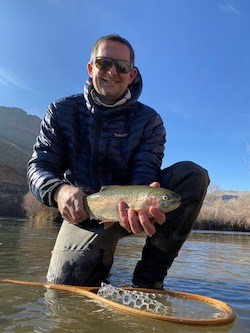
About the Author
My name's Sam and I'm a fly fishing enthusiast just like you. I get out onto the water 80+ times each year, whether it's blazing hot or snow is falling. I enjoy chasing everything from brown trout to snook, and exploring new waters is something I savor. My goal is to discover something new each time I hit the water. Along those lines, I record everything I learn in my fly fishing journal so I can share it with you.
Follow me on Instagram , YouTube, and Facebook to see pictures and videos of my catches and other fishing adventures!
